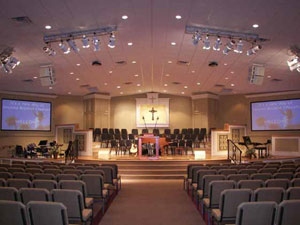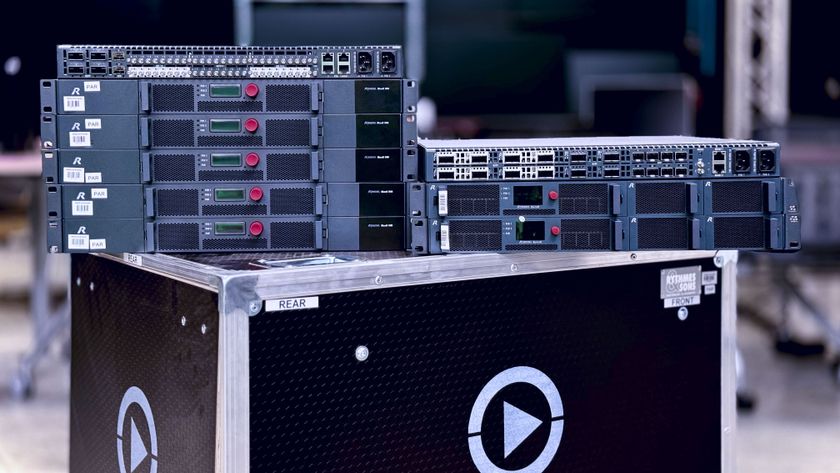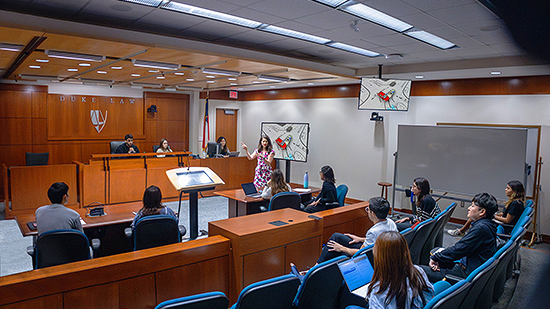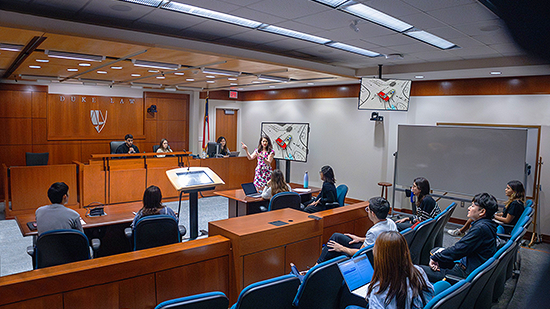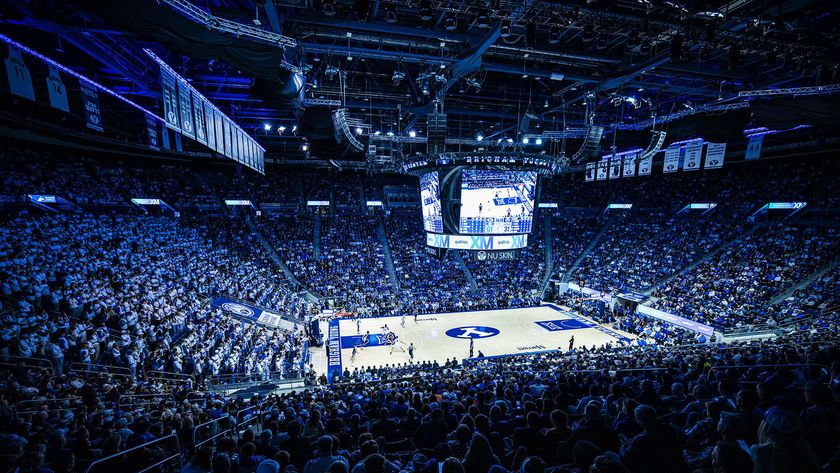How to Match Client Demands with Design Reality
Peavey Versarray 112 enclosures at Second Baptist Church in Cedartown, GA.
Tell me what you want. Then we’ll see what you need.
That should be the motto for every house of worship (HOW) line array request. Long thought of as the cure-all for audio systems design, line arrays are now available in a variety of sizes, columns, and configurations, which make them perfect for HOW. Or does it?
“I always tell my sales people to dig deeper when they get a specific product question to figure out what kind of problem the customer is trying to solve. In most cases, the customers don’t want to buy line arrays; they want to take care of a need and they’re asking about line arrays to fill that need,” said Chris Foreman, vice president/COO of Community Professional Loudspeakers. “Some customers may be technically knowledgeable enough to know exactly what they want. In others, they may have visited another house of worship with a line array and think it’s the solution for them, but the other HOW may have had completely different architecture.”
There are several major questions to ask the client, or if the church is a larger, contemporary venue, their technical director, added David Fuller, director of technical marketing at QSC Audio Products. “Firstly and most importantly, do they have the budget for line array? What are their actual performance requirements? Do they actually need a line array? Many clients want a line array simply because it’s a buzzword. And sometimes a client believes that a line array will solve the problem of bad room acoustics.”
There is no cure-all solution, said Jerrold Stevens, director of the application support group at EAW. “The best answer to a line array HOW request is, ‘We need to know a lot more about your application than the fact that it’s a house of worship before we can even think about specifying any particular loudspeaker system.’ The longstanding approach at EAW has been to develop a wide range of products that let designers develop the best possible solution to each and every project because they’re all different.”
Always try to determine why the customer thinks they need a line array, suggested David Rahn, North American sales manager at Alcons Audio. “This allows us to gauge the level of knowledge of the individual and to find out if decisions are being made by individuals or committees. And, in addition to room acoustics, take into consideration the geometry of the space, and architectural and aesthetic considerations such as sightlines and rigging points.”
In some cases a line array is the right fit, said Buck Waller, CEO of ISP Technologies. “In others, it’s being oversold to them, or they don’t understand what it is. A line array is the solution if one single box as a point source is not capable of providing the required SPL vertical and horizontal dispersion. Some churches would be better served with a single box as a point source.”
The question becomes this: Do they need larger vertical dispersion than what a single box would have and/or a higher SPL requirement? “In a concert environment where a single box won’t fill a hall, they used to stack multiple speakers on both sides of the stage, but the multiple speakers would interact with one another causing frequency response phase errors at different locations in the venue. It would sound completely different at different seats,” Waller said. “The major advantage of line array is: it’s a more eloquent way of having multiple speakers produce a higher SPL without the frequency response and phase errors of the past. But if you don’t need a higher SPL than a single cabinet can deliver you can get a more accurate and pure sound with a single box solution.”
There are some churches that may actually be better without a line array, Waller continued. “Sometimes, they want 60 degrees vertical but do not want to spend enough to do it properly. So, in many cases the line array cabinets are set at maximum splay angles, which may not provide the best performance for both projection and frequency response. A line array system can provide excellent performance if it’s implemented correctly with the proper design.”
The same questions should be asked before installing a line array in an HOW as with any other type of loudspeaker system installation, Stevens said. “What is the size and shape of your room? What kinds of architectural features might block sound from coverage areas? What kind of program material will you need to reproduce? What kinds of different events or uses will your sound system need to support?”
That said, for certain types of houses of worship, line arrays make a great deal of sense, he added. “For example, line arrays would work well in a fan-shaped auditorium without any obstructions into the main audience area and the facility is one in which fairly high energy music plays an important role in the service. Depending on the size and, in particular, the maximum depth of the room, designers would select a line array module and construct arrays of a certain size to develop the output and vertical pattern control required. Remember, a main line array is only part of the solution. You’ll still need to think about subwoofers, under-balcony coverage, and stage monitors, assuming the music is performed live. Always, we stress the importance of thinking systemically about the total needs of the application so you can develop a total solution.”
It’s essential that integrators understand the HOW’s architecture and the situation/ application. “For example, many of the newer Christian houses of worship with evangelical types of services have that fan-shaped auditorium with a wide stage and a relatively shallow audience area in comparison with the overall size of the space,” Foreman said. “If you install a line on each side you won’t be able to cover the center of the room near the stage. If you install a third line array in the center, you’re getting close to a design known as an exploded cluster which is a series of loudspeakers distributed around the front of the stage and pointed at the various audience areas. This design is normally implemented with conventional boxed loudspeakers like Community’s iBOX Series.”
The advantage of conventional loudspeakers in this design is that you can choose both the horizontal and vertical coverage pattern to fit the needs of the space, he added. “So, conventional boxed loudspeakers arranged in an exploded cluster may be the right choice in a fan-shaped HOW. But if you’ve got a deep, long room and try to use conventional boxed loudspeakers, you may get a poor result and that’s where a line array shines.”

A church service in Guatemala with Alcons Audio LR14 pro-ribbon line-arrays.
Always ask if the HOW has load bearing regions where the line array can be suspended above the stage. “Some of the older venues are often wooden structures, or above the ceiling the high metal I-beam or structural supports may be in a less desirable location,” Fuller said.
Even worse, there could be nothing load rated at all. “One of the biggest difficulties with placing a line array is finding points to hang it from,” he explained. “Sightlines are another challenge. In a traditional venue, with stained glass on a back wall or a large array of organ pipes, the last thing the client wants is a speaker array in front of a large crucifix in the center of the room. A lot of new contemporary churches are wider, with screens on the left and right sides of the stage, which just happens to be where you would naturally hang a line array.”
Karen Mitchell is a freelance writer based in Boulder, CO.
Don’t Marginalize Your Margin
The competitive landscape makes it hard to make good margin on product alone in the house of worship world. “The integrator has to be able to sell their capabilities as well as the quality of the design and tools they have chosen for the design,” said David Rahn of Alcons. “Proper after-the-sale support and training add a lot of value as well since the technology is often beyond that of the typical user.”
It all comes down to a meticulous design. “Certainly, we feel that the integrator should provide the best value and the best possible sound for the budget, but it still comes down to careful design,” said Buck Waller of ISP Technologies. “The integrator will lose dollars with an inefficient system that they have to service frequently.”
Keep in mind that a house of worship customer will buy a sound system once in 10 years, or even longer. “Commonly, there is a committee making the buying decision, and no one on that committee may have done this before,” said Chris Foreman of Community. “For this reason, the integrator needs to help the HOW understand their real needs before recommending a sound system design. Professional audio products are more commoditized than ever and integrators must compete with internet and catalog sales houses.”
Start with competitive prices, but add profit with service contracts and other value-added products and services, he advised. “It’s important to know how to sell the value you bring to the table. For example, a wireless mic system needs to be properly designed with coordinated frequencies and antenna system design. Make sure the customer knows that you, the integrator, are doing more than just selling the hardware.”
The short answer, said Jerrold Stevens of EAW, is to play it smart. “Do your homework, and plan, plan, plan. Making money on an installation comes down to execution, so the more variables you can eliminate, the more likely you are to come out on the good side financially. Maybe you save a few percent specifying a lower-cost line array, but then you spend several days working with the processing and EQ to get it to perform the way you need it to. You’ve lost your savings and then some.”
—Karen Mitchell
Alcons LR7

The LR7 is a passive, two-way line-source loudspeaker system that can be used as a vertical array, either in stacked or flown configuration, for portable and permanent installations. A 74-hertz to over 20-kilohertz frequency response allows for full-range deploymen.
EAW DF740

This three-way, full range line array loudspeaker from EA W features a symmetrical design, large horn, and spaced woofers, as well as EA W Focusing and EA W Resolution software.
JBL VT4886

Given its compact dimensions, the VT 4886 is appropriate for distributed front fill or under-balcony use. VT 4886 line array elements can also be suspended in large multi-box arrays or ground-stacked, either standalone or with its companion VT 4883 lowfrequency extension.
d&b audiotechnik 10AL/10AL-D

The d&b audiotechnik xASeries 10AL/10AL-D line source loudspeakers enable vertical array design of high quality and performance, and are available with special colors and weather resistant options.
L-Acoustics ARCS II

The bi-amplified ARCS II enclosure is based on a two-way active design and offers L-Acoustics’ K1 grade transducers for increased SPL to 140 decibels and lower weight, down to 110 pounds per 50 kilogram.
Community ENTASYS

Community ENTASYS features a three-way full-range column and a low frequency column in the same size enclosure. ENTASYS offers high output and high power handling capability, with multiple low frequency, midrange, and high-frequency drivers for consistent, lobe free, coverage, and delivering a constant vertical beam width from 800 hertz to 16 kilohertz.
Peavey Versarray 212

The Versarray 212 ribbon tweeter line source array module consists of dual 12-inch Neo Black Widow woofers combined with a neodymium-based midrange line array and planar ribbon tweeter line source in a cabinet with a flexible rigging system.
Electro-Voice EVA Series

The EVA (expandable vertical array) series features multi-driver Hydra generators that use two compression drivers to feed each waveguide, providing both sound pressure level and dynamic range. Designed for single amp channel drive, the system includes two vertical and two horizontal patterns for flexibility. .
Bose Panaray MA12EX

The Panaray MA12EX modular line array loudspeaker from Bose includes 12 2.25-inchhigh excursion, weatherresistant drivers that deliver extended low-frequency response for accurate music reproduction.
QSC KLA Series
The QSC KLA Series is a fixed arcuate, 18-degree line array solution for various portable and fixed installation solutions. Ar-Q manages array-size frequency optimization with a simple dial turn.
Meyer Sound MINA

MINA is less than 18.5 inches wide, yet capable of producing up to 128 decibels at one meter. Its operating frequency ranges from 75 hertz to 18 kilohertz over a 100-degree horizontal coverage area.
Yamaha Nexo GEO S1210/ S1230

The Nexo GEO S1210/ S1230 speaker cabinets are based upon a 12-inch low driver and three-inch compression driver, and are intended to be a scalable building block that can be stacked or positioned in a horizontal or vertical array.
ISP HDL Series
HDL4212 line array speakers are a true four-way design. The HDL4212 and smaller 4210 provide a fully symmetrical design with separate low-mid and highmid bands, transforming midrange clarity without inter-modulation distortion.
Martin Audio OMNILINE

Each OMNILINE array is constructed by connecting together multiple array modules. Up to 32 of these modules can be connected.
